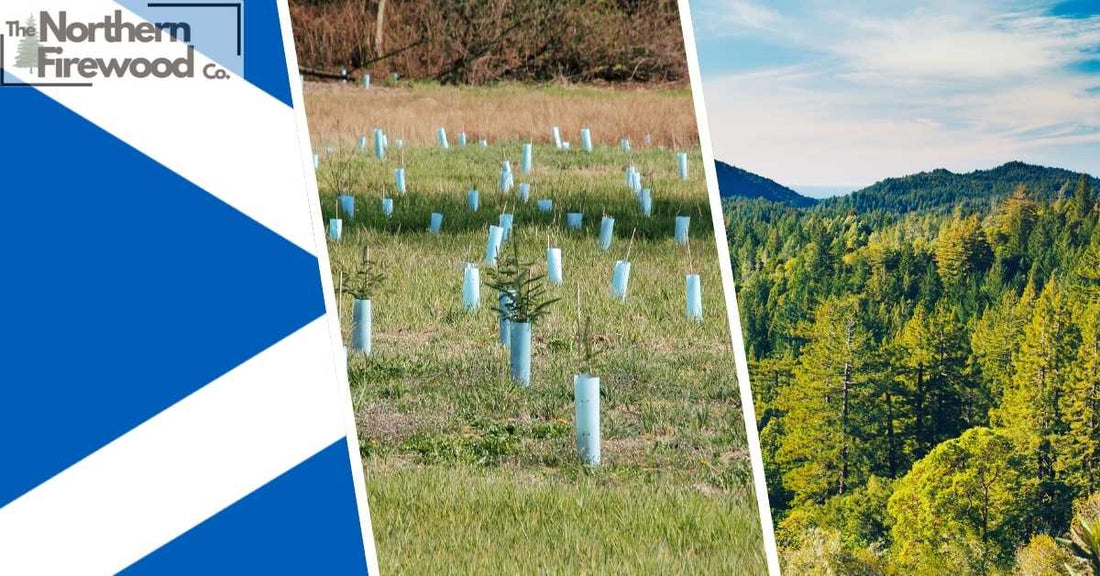
Scotland's Woodland Renaissance: A Decade of Growth and Change
Share
Over the past decade, Scotland has been at the forefront of woodland creation in the UK, consistently leading the way in new tree planting. This commitment to expanding and diversifying our forests has yielded impressive results, but also faced challenges. Let's explore the statistics, species diversity, and outcomes of Scotland's reforestation efforts.
Planting Progress
Scotland has made significant strides in woodland creation:
-
In 2021-22, Scotland planted 10,480 hectares of new woodland, accounting for over 75% of all new planting in the UK.
-
The 2023-24 planting season saw a remarkable increase, with more than 15,000 hectares of new forests created in Scotland.
-
This recent achievement represents the highest level of tree planting in Scotland in the modern generation.
However, it's important to note that targets haven't always been met:
-
The 2022-23 planting season fell short, with 8,190 hectares planted against a target of 15,000 hectares.
-
Despite this setback, Scotland consistently creates over 60% of all new woodlands in the UK.
Hardwood v Softwood
Scotland's forests are predominantly coniferous, with important distinctions between softwood and hardwood species:
-
Conifers make up 82% of Scotland's trees, primarily producing softwood for construction, paper, and other wood products.
-
Softwoods, like Sitka spruce and various pines, grow faster and are generally cheaper and easier to work with.
-
Hardwoods, such as oak, ash, and birch, account for the remaining 18% and are valued for conservation and landscape benefits.
In the 2023-24 planting season:
-
8,720 hectares of conifers were planted
-
6,320 hectares of broadleaf trees were established
Successes and Challenges
Successes:
-
Increased biodiversity: New plantings often replace monoculture plantations with mixed-species woodlands, enhancing ecosystem resilience.
-
Economic growth: The forestry sector has seen significant investment, creating jobs and supporting rural economies.
-
Climate action: Expanded woodlands contribute to carbon sequestration, aiding Scotland's net-zero targets.
Challenges:
-
Meeting targets: Despite progress, Scotland has occasionally fallen short of its ambitious planting goals.
-
Native woodland targets: In 2022-23, Scotland achieved only 74% of its 4,000-hectare native woodland planting target.
-
Balancing species: While conifers dominate for timber production, there's a need to increase hardwood planting for ecological diversity.
Looking Ahead
Scotland's forestry sector remains committed to growth and sustainability. The government has set increasingly ambitious targets, aiming for 15,000 hectares of new woodland annually by 2024-2025. This goal reflects a balance between productive forestry and native woodland restoration.
As Scotland continues its woodland renaissance, the focus remains on creating diverse, resilient forests that serve multiple purposes – from timber production to wildlife habitats and recreational spaces. By learning from past successes and addressing ongoing challenges, Scotland is poised to maintain its position as a leader in sustainable forestry practices across the UK.
Sources
https://www.confor.org.uk/news/latest-news/new-woodland-creation-statistics-scotland-update/
https://forestryandland.gov.scot/what-we-do/timber-industry/planting-and-felling-faqs
https://www.confor.org.uk/news/latest-news/scotland-leads-way-on-uk-tree-planting-but-misses-target/
https://cdn.forestresearch.gov.uk/2002/03/fcms105.pdf
https://www.forestry.gov.scot/news-releases/blog-new-woodland-stats-a-more-in-depth-look
https://www.charteredforesters.org/scotland-delivers-nearly-80-of-uk-new-planting
